
Imperial City (Beijing)
Encyclopedia
The Imperial City is a section of the city of Beijing
in the Ming
and Qing
dynasties, with the Forbidden City
at its center. It refers to the collection of gardens, shrines, and other service areas between the Forbidden City and the Inner City of ancient Beijing. The Imperial City was surrounded by a wall
and accessed through six gates and it includes such historical places as the Forbidden City, Tiananmen
, Zhongnanhai
, Beihai Park
, Zhongshan Park
, Jingshan
, Imperial Ancestral Temple, and Xiancantan
.
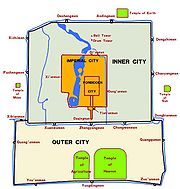
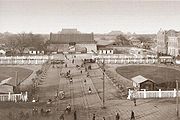

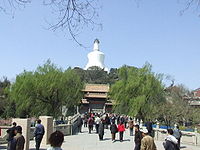
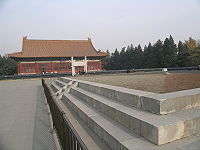
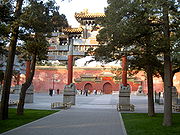 In the Yuan dynasty
In the Yuan dynasty
, Beijing was known as Dadu
, and the Imperial City formed the centre of the city. In 1368, the Ming
armies conquered Dadu
, and changed its name to "Beiping" (the two characters meaning "north" and "peace" or "pacified"), with the capital moved to Nanjing
. Because the Imperial City was untouched by battle, most of the Imperial City survived the war; however, in 1369, the Hongwu Emperor
ordered that the Imperial City be demolished.
In 1370, the Hongwu Emperor
's fourth son Zhu Di was created Prince of Yan, with seat in Beiping. In 1379 he built a princely palace within the Yuan
Imperial City.
In 1399, Zhu Di launched a coup d'état and ascended to the throne to become Yongle Emperor
in 1402. In 1403, the name of Beiping was changed to Beijing (literally "the Northern Capital"), and in 1406 a plan was drafted to move the capital to Beijing.
In 1406, construction of the Forbidden City
began, copying the layout of the existing palaces in Nanjing
. The new imperial palace was placed to the east of the Yuan palace, in order to place the Yuan palace in the "White Tiger" or "Kill" position in feng shui. Also for feng shui reasons, earth dug up from construction of the moat were used to construct Jingshan Hill
to the north of the imperial palace.
On the basis of the Yuan Imperial City, the area was expanded to encompass the lakes of Zhongnanhai
and Beihai
and a significant area beyond.
To the south of the forbidden City are the Imperial Shrine of Family or Imperial Ancestral Temple (太庙) and Shrine of State (太社稷). Further to the south was the "Corridor of a Thousand Steps", to either side of which are the offices
of the various government ministries.
There are six gates in the walls of the Imperial City. To the south is the Great Ming Gate (later renamed the Great Qing Gate, Gate of China
). Behind the Great Ming Gate was the Chengtianmen, (later renamed the Tian'anmen
, "Gate of Heavenly Peace"). To either side of the Tiananmen were the Left Chang'an Gate and the Right Chang'an Gate. To the east was Donganmen ("Gate of Eastern Peace"); to the west was the Xi'anmen ("Gate of Western Peace"). To the north was Houzaimen (later renamed the Di'anmen, "Gate of Earthly Peace").
Also housed in the Imperial City were a number of service buildings for the imperial palace, warehouses, Taoist
temples, and a palace for the Imperial Grandson.
, the rulers of the Qing removed most of the service buildings. Apart from a narrow area surrounding the lakes of Zhongnanhai and Beihai, the western parts of the Imperial City were given to princes and members of the Eight Banners
as residential land. Likewise, apart from a small number of warehouses, the eastern parts of the Imperial City were also given to members of the Eight Banners
as residential land. To the collection of temples in the Imperial City was added a Catholic church on the western shore of Zhongnanhai.
in 1912, the Republic of China
government took over the Imperial City. Zhongnanhai was, for a time, converted into the Presidential Palace. The Imperial Shrines became a part of the Palace Museum
. Beihai and Jingshan
became public parks. Most of the former temples and imperial warehouses gradually became private residences.
In 1912, during a coup by warlord Cao Kun
, the Donganmen gate was destroyed by fire. In 1914, the Corridor of a Thousand Steps was demolished to make way for Zhongshan Park, named after Sun Yat-sen
. In 1915, in order to improve traffic, much of the wall surrounding the Imperial City was demolished. After the capital was moved to Nanjing
, Zhongnanhai became a public park.
In 1949, the People's Republic of China
was established in Beijing. In the next few years, Gate of China, Left Chang'an Gate, Right Chang'an Gate, the three remaining eastern and western gates, and Di'anmen were demolished. Zhongnanhai
became the leadership compound of the new government, housing the central headquarters of the Communist Party of China
and the State Council. Many of the surviving buildings in the former garden were demolished.
The area to the west of Beihai Park
were occupied by the Department of Defence, with a large office building now dominating the park skyline. Most of the temples in the Imperial City were occupied by units of the People's Liberation Army
. Some of these buildings remain occupied and are in severe disrepair.
In recent decade, the Beijing municipal government has restored several of these temples, and established a park around the remaining sections of the Imperial City wall. Plans were drawn up to gradually move out institutions occupying various historical buildings . In 2004, a 1984 ordinance relating to building height and planning restriction was renewed to establish the Imperial City area and the northern city area as a buffer zone for the Forbidden City
. In 2005, a proposal was released to include the Imperial City and Beihai as extension items to the Forbidden City as a World Heritage Site
.
Beijing
Beijing , also known as Peking , is the capital of the People's Republic of China and one of the most populous cities in the world, with a population of 19,612,368 as of 2010. The city is the country's political, cultural, and educational center, and home to the headquarters for most of China's...
in the Ming
Ming Dynasty
The Ming Dynasty, also Empire of the Great Ming, was the ruling dynasty of China from 1368 to 1644, following the collapse of the Mongol-led Yuan Dynasty. The Ming, "one of the greatest eras of orderly government and social stability in human history", was the last dynasty in China ruled by ethnic...
and Qing
Qing Dynasty
The Qing Dynasty was the last dynasty of China, ruling from 1644 to 1912 with a brief, abortive restoration in 1917. It was preceded by the Ming Dynasty and followed by the Republic of China....
dynasties, with the Forbidden City
Forbidden City
The Forbidden City was the Chinese imperial palace from the Ming Dynasty to the end of the Qing Dynasty. It is located in the middle of Beijing, China, and now houses the Palace Museum...
at its center. It refers to the collection of gardens, shrines, and other service areas between the Forbidden City and the Inner City of ancient Beijing. The Imperial City was surrounded by a wall
Chinese city wall
Chinese city walls refer to civic defensive systems used to protect towns and cities in China in pre-modern times. The system consisted of walls, towers, and gates, which were often built to a uniform standard throughout the Empire....
and accessed through six gates and it includes such historical places as the Forbidden City, Tiananmen
Tiananmen
The Tiananmen, Tian'anmen or Gate of Heavenly Peace is a famous monument in Beijing, the capital of the People's Republic of China. It is widely used as a national symbol. First built during the Ming Dynasty in 1420, Tian'anmen is often referred to as the front entrance to the Forbidden City...
, Zhongnanhai
Zhongnanhai
Zhongnanhai is an area in central Beijing, China adjacent to the Forbidden City which serves as the central headquarters for the Communist Party of China and the State Council of the People's Republic of China. The term Zhongnanhai is closely linked with the central government and senior Communist...
, Beihai Park
Beihai Park
Beihai Park is an imperial garden to the northwest of the Forbidden City in Beijing. First built in the 10th century, it is amongst the largest of Chinese gardens, and contains numerous historically important structures, palaces and temples. Since 1925, the place has been open to the public as a...
, Zhongshan Park
Zhongshan Park (Beijing)
The Zhongshan Park , is a former imperial garden and now a public park that lies just southwest of the Forbidden City in the Dongcheng District of central Beijing....
, Jingshan
Jingshan Park
Jingshan is an artificial hill in Beijing, China. Covering an area of more than 230,000 m², Jingshan is immediately north of the Forbidden City on the central axis of Beijing. As a result, it is administratively part of both the Xicheng District and the Dongcheng District...
, Imperial Ancestral Temple, and Xiancantan
Xiancantan
The Xiancantan , known in English as Altar to the Goddess of Silkworms, is an imperial altar in Beijing, China, similar to the Imperial Ancestral Hall, Xiannongtan and the Altar of Earth and Harvests. It is located at the eastern ground of the Beihai Park, a large imperial garden in the city's...
.
Construction






Yuan Dynasty
The Yuan Dynasty , or Great Yuan Empire was a ruling dynasty founded by the Mongol leader Kublai Khan, who ruled most of present-day China, all of modern Mongolia and its surrounding areas, lasting officially from 1271 to 1368. It is considered both as a division of the Mongol Empire and as an...
, Beijing was known as Dadu
Khanbaliq
Khanbaliq or Dadu refers to a city which is now Beijing, the current capital of the People's Republic of China...
, and the Imperial City formed the centre of the city. In 1368, the Ming
Ming Dynasty
The Ming Dynasty, also Empire of the Great Ming, was the ruling dynasty of China from 1368 to 1644, following the collapse of the Mongol-led Yuan Dynasty. The Ming, "one of the greatest eras of orderly government and social stability in human history", was the last dynasty in China ruled by ethnic...
armies conquered Dadu
Khanbaliq
Khanbaliq or Dadu refers to a city which is now Beijing, the current capital of the People's Republic of China...
, and changed its name to "Beiping" (the two characters meaning "north" and "peace" or "pacified"), with the capital moved to Nanjing
Nanjing
' is the capital of Jiangsu province in China and has a prominent place in Chinese history and culture, having been the capital of China on several occasions...
. Because the Imperial City was untouched by battle, most of the Imperial City survived the war; however, in 1369, the Hongwu Emperor
Hongwu Emperor
The Hongwu Emperor , known variably by his given name Zhu Yuanzhang and by his temple name Taizu of Ming , was the founder and first emperor of the Ming Dynasty of China...
ordered that the Imperial City be demolished.
In 1370, the Hongwu Emperor
Hongwu Emperor
The Hongwu Emperor , known variably by his given name Zhu Yuanzhang and by his temple name Taizu of Ming , was the founder and first emperor of the Ming Dynasty of China...
's fourth son Zhu Di was created Prince of Yan, with seat in Beiping. In 1379 he built a princely palace within the Yuan
Yuan Dynasty
The Yuan Dynasty , or Great Yuan Empire was a ruling dynasty founded by the Mongol leader Kublai Khan, who ruled most of present-day China, all of modern Mongolia and its surrounding areas, lasting officially from 1271 to 1368. It is considered both as a division of the Mongol Empire and as an...
Imperial City.
In 1399, Zhu Di launched a coup d'état and ascended to the throne to become Yongle Emperor
Yongle Emperor
The Yongle Emperor , born Zhu Di , was the third emperor of the Ming Dynasty of China from 1402 to 1424. His Chinese era name Yongle means "Perpetual Happiness".He was the Prince of Yan , possessing a heavy military base in Beiping...
in 1402. In 1403, the name of Beiping was changed to Beijing (literally "the Northern Capital"), and in 1406 a plan was drafted to move the capital to Beijing.
In 1406, construction of the Forbidden City
Forbidden City
The Forbidden City was the Chinese imperial palace from the Ming Dynasty to the end of the Qing Dynasty. It is located in the middle of Beijing, China, and now houses the Palace Museum...
began, copying the layout of the existing palaces in Nanjing
Nanjing
' is the capital of Jiangsu province in China and has a prominent place in Chinese history and culture, having been the capital of China on several occasions...
. The new imperial palace was placed to the east of the Yuan palace, in order to place the Yuan palace in the "White Tiger" or "Kill" position in feng shui. Also for feng shui reasons, earth dug up from construction of the moat were used to construct Jingshan Hill
Jingshan Park
Jingshan is an artificial hill in Beijing, China. Covering an area of more than 230,000 m², Jingshan is immediately north of the Forbidden City on the central axis of Beijing. As a result, it is administratively part of both the Xicheng District and the Dongcheng District...
to the north of the imperial palace.
On the basis of the Yuan Imperial City, the area was expanded to encompass the lakes of Zhongnanhai
Zhongnanhai
Zhongnanhai is an area in central Beijing, China adjacent to the Forbidden City which serves as the central headquarters for the Communist Party of China and the State Council of the People's Republic of China. The term Zhongnanhai is closely linked with the central government and senior Communist...
and Beihai
Beihai Park
Beihai Park is an imperial garden to the northwest of the Forbidden City in Beijing. First built in the 10th century, it is amongst the largest of Chinese gardens, and contains numerous historically important structures, palaces and temples. Since 1925, the place has been open to the public as a...
and a significant area beyond.
Ming dynasty
The Imperial City centres on the Forbidden City. To the west of the Forbidden City are the Zhongnanhai and Beihai, which were surrounded by imperial gardens and collectively known as the Western Park.To the south of the forbidden City are the Imperial Shrine of Family or Imperial Ancestral Temple (太庙) and Shrine of State (太社稷). Further to the south was the "Corridor of a Thousand Steps", to either side of which are the offices
Yamen
A yamen is any local bureaucrat's, or mandarin's, office and residence of the Chinese Empire. The term has been widely used in China for centuries, but appeared in English during the Qing Dynasty....
of the various government ministries.
There are six gates in the walls of the Imperial City. To the south is the Great Ming Gate (later renamed the Great Qing Gate, Gate of China
Gate of China, Beijing
The Gate of China in Beijing was a historical ceremonial gateway in Beijing, China, located near the centre of today's Tiananmen Square. It was demolished in 1954. This gate formed the southern gate of the Imperial City during the Ming and Qing dynasties. It was situated on the central axis of...
). Behind the Great Ming Gate was the Chengtianmen, (later renamed the Tian'anmen
Tiananmen
The Tiananmen, Tian'anmen or Gate of Heavenly Peace is a famous monument in Beijing, the capital of the People's Republic of China. It is widely used as a national symbol. First built during the Ming Dynasty in 1420, Tian'anmen is often referred to as the front entrance to the Forbidden City...
, "Gate of Heavenly Peace"). To either side of the Tiananmen were the Left Chang'an Gate and the Right Chang'an Gate. To the east was Donganmen ("Gate of Eastern Peace"); to the west was the Xi'anmen ("Gate of Western Peace"). To the north was Houzaimen (later renamed the Di'anmen, "Gate of Earthly Peace").
Also housed in the Imperial City were a number of service buildings for the imperial palace, warehouses, Taoist
Taoism
Taoism refers to a philosophical or religious tradition in which the basic concept is to establish harmony with the Tao , which is the mechanism of everything that exists...
temples, and a palace for the Imperial Grandson.
Qing dynasty
After the fall of the Ming DynastyMing Dynasty
The Ming Dynasty, also Empire of the Great Ming, was the ruling dynasty of China from 1368 to 1644, following the collapse of the Mongol-led Yuan Dynasty. The Ming, "one of the greatest eras of orderly government and social stability in human history", was the last dynasty in China ruled by ethnic...
, the rulers of the Qing removed most of the service buildings. Apart from a narrow area surrounding the lakes of Zhongnanhai and Beihai, the western parts of the Imperial City were given to princes and members of the Eight Banners
Eight Banners
The Eight Banners were administrative divisions into which all Manchu families were placed. They provided the basic framework for the Manchu military organization...
as residential land. Likewise, apart from a small number of warehouses, the eastern parts of the Imperial City were also given to members of the Eight Banners
Eight Banners
The Eight Banners were administrative divisions into which all Manchu families were placed. They provided the basic framework for the Manchu military organization...
as residential land. To the collection of temples in the Imperial City was added a Catholic church on the western shore of Zhongnanhai.
Republic of China to present
After the fall of the Qing dynastyQing Dynasty
The Qing Dynasty was the last dynasty of China, ruling from 1644 to 1912 with a brief, abortive restoration in 1917. It was preceded by the Ming Dynasty and followed by the Republic of China....
in 1912, the Republic of China
Republic of China
The Republic of China , commonly known as Taiwan , is a unitary sovereign state located in East Asia. Originally based in mainland China, the Republic of China currently governs the island of Taiwan , which forms over 99% of its current territory, as well as Penghu, Kinmen, Matsu and other minor...
government took over the Imperial City. Zhongnanhai was, for a time, converted into the Presidential Palace. The Imperial Shrines became a part of the Palace Museum
Forbidden City
The Forbidden City was the Chinese imperial palace from the Ming Dynasty to the end of the Qing Dynasty. It is located in the middle of Beijing, China, and now houses the Palace Museum...
. Beihai and Jingshan
Jingshan Park
Jingshan is an artificial hill in Beijing, China. Covering an area of more than 230,000 m², Jingshan is immediately north of the Forbidden City on the central axis of Beijing. As a result, it is administratively part of both the Xicheng District and the Dongcheng District...
became public parks. Most of the former temples and imperial warehouses gradually became private residences.
In 1912, during a coup by warlord Cao Kun
Cao Kun
|-...
, the Donganmen gate was destroyed by fire. In 1914, the Corridor of a Thousand Steps was demolished to make way for Zhongshan Park, named after Sun Yat-sen
Sun Yat-sen
Sun Yat-sen was a Chinese doctor, revolutionary and political leader. As the foremost pioneer of Nationalist China, Sun is frequently referred to as the "Father of the Nation" , a view agreed upon by both the People's Republic of China and the Republic of China...
. In 1915, in order to improve traffic, much of the wall surrounding the Imperial City was demolished. After the capital was moved to Nanjing
Nanjing
' is the capital of Jiangsu province in China and has a prominent place in Chinese history and culture, having been the capital of China on several occasions...
, Zhongnanhai became a public park.
In 1949, the People's Republic of China
People's Republic of China
China , officially the People's Republic of China , is the most populous country in the world, with over 1.3 billion citizens. Located in East Asia, the country covers approximately 9.6 million square kilometres...
was established in Beijing. In the next few years, Gate of China, Left Chang'an Gate, Right Chang'an Gate, the three remaining eastern and western gates, and Di'anmen were demolished. Zhongnanhai
Zhongnanhai
Zhongnanhai is an area in central Beijing, China adjacent to the Forbidden City which serves as the central headquarters for the Communist Party of China and the State Council of the People's Republic of China. The term Zhongnanhai is closely linked with the central government and senior Communist...
became the leadership compound of the new government, housing the central headquarters of the Communist Party of China
Communist Party of China
The Communist Party of China , also known as the Chinese Communist Party , is the founding and ruling political party of the People's Republic of China...
and the State Council. Many of the surviving buildings in the former garden were demolished.
The area to the west of Beihai Park
Beihai Park
Beihai Park is an imperial garden to the northwest of the Forbidden City in Beijing. First built in the 10th century, it is amongst the largest of Chinese gardens, and contains numerous historically important structures, palaces and temples. Since 1925, the place has been open to the public as a...
were occupied by the Department of Defence, with a large office building now dominating the park skyline. Most of the temples in the Imperial City were occupied by units of the People's Liberation Army
People's Liberation Army
The People's Liberation Army is the unified military organization of all land, sea, strategic missile and air forces of the People's Republic of China. The PLA was established on August 1, 1927 — celebrated annually as "PLA Day" — as the military arm of the Communist Party of China...
. Some of these buildings remain occupied and are in severe disrepair.
In recent decade, the Beijing municipal government has restored several of these temples, and established a park around the remaining sections of the Imperial City wall. Plans were drawn up to gradually move out institutions occupying various historical buildings . In 2004, a 1984 ordinance relating to building height and planning restriction was renewed to establish the Imperial City area and the northern city area as a buffer zone for the Forbidden City
Forbidden City
The Forbidden City was the Chinese imperial palace from the Ming Dynasty to the end of the Qing Dynasty. It is located in the middle of Beijing, China, and now houses the Palace Museum...
. In 2005, a proposal was released to include the Imperial City and Beihai as extension items to the Forbidden City as a World Heritage Site
World Heritage Site
A UNESCO World Heritage Site is a place that is listed by the UNESCO as of special cultural or physical significance...
.

